Image set

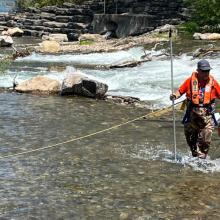
Related services
Related sectors
Related regions
Opening article section
Article section
Rich text
Summary of the in-stream spawning ground development project
As part of the restoration work at Hydro-Québec’s Beauharnois–Les Cèdres hydroelectric complex, the Englobe team successfully delivered an innovative, sustainable, and exemplary project: the development of an in-stream spawning ground downstream from the Saint-Timothée dam.
The neighbouring community is located at the eastern end of the town of Salaberry-de-Valleyfield, along the St. Lawrence River in Québec.
Media
Image set
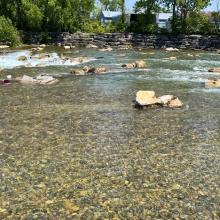
Rich text
In-steam spawning ground development project: background and challenges
This complex consists of two hydroelectric power plants, Les Cèdres (in operation from 1911 to 1914) and Beauharnois (in operation from 1932 to 1961). These infrastructures required certain works, including improving the impermeability and stabilization of the embankment on the right bank of the headrace canal, and installing an “inverse filter” in the Saint-Timothée and Pointe-du-Buisson basins.
The purpose of this project was to partially compensate for the loss and disruption of aquatic habitats caused by these works, as well as by the repair of the Les Cèdres dike. These habitat losses (destruction and/or permanent alteration of certain zones) amounted to nearly 69,000 m2; the impacted habitat types were stillwater aquatic environments consisting of rocky feeding habitats with the presence of spawning habitat for smallmouth bass as well as aquatic grass beds.
Initially, Englobe's role was to propose offsetting habitats of equivalent size and quality to the habitat losses. A wide variety of offsetting habitats were proposed, and four types were selected: stillwater spawning grounds for smallmouth bass, aquatic grass beds as feeding and nursery habitats, a multi-species spawning ground combined with a live-water feeding site, and finally, feeding sites in rocky environments in shallow waters.
Media
Image set

Rich text
How the Englobe team overcame complexities in developing the spawning ground
The main challenge of this project was to transform a low-quality breeding habitat whose current speeds and water depths were too high for fish to use (up to 3,500 m3/s), whether the spillway gates were open or not. Even without discharge, very high speeds of more than 1.5 m/s are observed.
The Englobe team’s role was to develop this sector into a whitewater breeding habitat offering stable hydraulic conditions (constant flow of 15.7 m³/s) conducive to spawning and to create a significant gain for the fish community of the Pointe-du-Buisson basin downstream.
In addition, a substrate composed of bedrock, boulders, and pebbles flowed into a relatively deep basin at a depth of roughly five metres.
Media
Image set

Rich text
The Englobe team demonstrates innovation during the spawning ground construction project
The concept of the proposed development had to integrate the variability of the hydraulic conditions of the sector due to the presence of the spillway. The concept chosen was to develop an artificial river downstream of the skimmer.
The Englobe team’s proposed design transformed this low-value breeding habitat into a high-quality, stable, and sustainable ecosystem covering a total area of 8,700 m² (325 m long and between 15 and 50 m wide).
The team took advantage of the basins’s annual low-water period between November and April to begin dry construction. The spawning ground was built using more than 15,000 m3 of stones and spawning substrate.
This artificial spawning ground has been integrated into the site’s complex hydraulic conditions. It maintains a constant 15.7 m3/s flow, enabling current velocities and depths that are conducive to fish reproduction. The addition of clean, minimally-silted substrate and the presence of 130 rocky islets also provide optimal spawning conditions.
Media
Image set
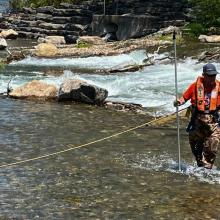
Rich text
Physical follow-up to assess the success of the spawning ground construction projectt
The success of this design was confirmed by the results of a physical follow-up carried out one year after completion of the work.
As anticipated, there was some movement of the spawning substrate after one year due to flow conditions. However, most of this substrate remained in place, with the exception of two areas subject to stronger currents. The concrete walls installed to maintain the spawning substrate in place also proved to be efficient.
Rich text
Biological monitoring of the spawning ground construction project
Two biological sampling follow-ups were also carried out in spring 2023 and again in spring 2025. These interventions revealed a high concentration of spawners.
In addition, tens of thousands of eggs and larvae from 14 species of fish were captured, including those of silver, shorthead and greater redhorse, white sucker, walleye, smallmouth bass, and several others.
Article quote
Media
Image set
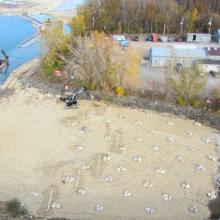
Rich text
Benefits of the in-stream spawning ground downstream from the Saint-Timothée dam
This large-scale project generated many significant benefits for local communities, including:
Social benefits:
This project was carried out on Hydro-Québec land and adjacent areas. Aside from materials transport, the construction project minimally impacted local residents.
Economic benefits:
This major development provided business opportunities for local contractors, thereby contributing to the area’s economic growth.
Environmental benefits:
The project's primary objective was to transform a low-value aquatic habitat into 8,700 m² of fish spawning and feeding grounds, which were lacking in the Pointe-du-Buisson basin. It should be noted that the spawning ground’s construction did not negatively impact other terrestrial or wetland habitats in the area. This design is also highly reproducible and suitable for other sites.
Media
Image set
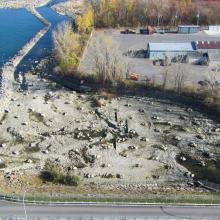
Rich text
Conclusion of the in-stream spawning ground development project
Englobe’s contributions to this project enabled the creation of a unique habitat at the head of a reservoir in the Pointe-du-Buisson basin, in an area with few ecosystems of this type.
This project also stands out for its significant ecological contributions to a basin with a dearth of live-water spawning habitats, and serves as proof of concept that it is possible to 'add a river to a reservoir'.